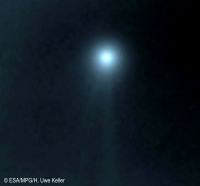No. 15 - Moving towards Cruise Phase
On the subsystems side two passes were dedicated to TTC commissioning. The LGA TC threshold test could not be completed due to a problem in the New Norcia station, which prevented the use of the Low Power Amplifier. Due to the relatively short distance to the Earth, the low threshold for LGA commanding could not be reached with the High Power Amplifier and the test will have to be re-scheduled to a later stage in the Cruise. On a second New Norcia pass the S-band ranging test with both transponders was successfully completed.
An important mission milestone this week was the fact that for the first time one of the daily New Norcia passes was skipped on 30 May. This means that Rosetta was left without ground contact for 42 hours. The spacecraft was prepared on the day before (reduce TM generation rate, increase TC link timeout) and was found in a perfect state when contact was re-acquired on the evening of 31 May. It is planned to gradually increase the period of non-contact during the first month of Cruise 1, to arrive at weekly passes by mid July.
The table below shows a chronology of the main activities in the reporting period:
|
Mission Day |
Date |
DOY |
Main Activity |
|
88 |
28/29.05.04 |
149/150 |
ALICE Performance Aliveness Test |
|
89 |
29/30.05.04 |
150/151 |
Prepare to skip pass, dump ALICE PAT data |
|
90 |
30/31.05.04 |
151/152 |
First skipped ground contact! |
|
91 |
31.05/01.06.04 |
152/153 |
Monitoring pass |
|
92 |
01/02.06.04 |
153/154 |
LGA TC threshold test |
|
93 |
02/03.06.04 |
154/155 |
S-band ranging test |
|
94 |
03/04.06.04 |
155/156 |
OSIRIS extra slot pass 1 |
At the end of the last New Norcia pass in the reporting period (DOY 156, 02:00) Rosetta was at 44.7 million km from the Earth. The one-way signal travel time was 2 minutes 29 seconds.
Science Results
 |
|
Comet C/2002 T7 (LINEAR) |
On 30 April Rosetta targeted the comet C/2002 T7 (LINEAR) for its first scientific observations. Data was successfully acquired by the four instruments ALICE, MIRO, VIRTIS and OSIRIS and will be fully analysed after the calibration of the instruments is completed.
OSIRIS acquired this image of the comet at a distance of about 95 million kilometres through a blue filter, showing the comet's nucleus and tenuous tail extending for over 2 million km.


